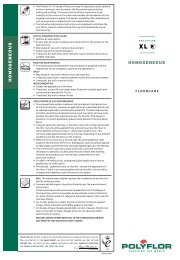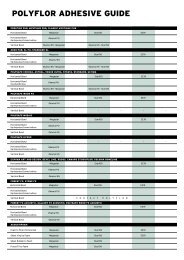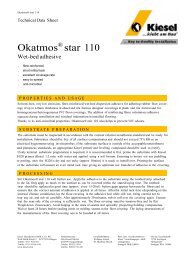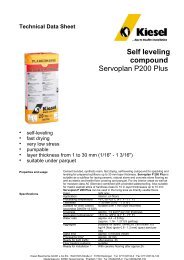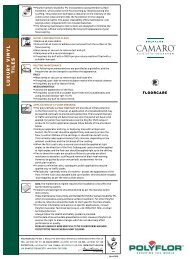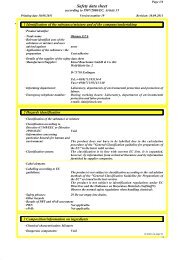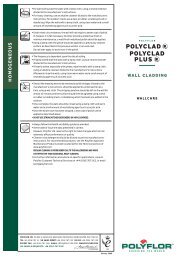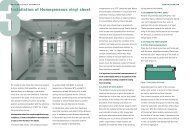MSDS Part 1 - Polyflor
MSDS Part 1 - Polyflor
MSDS Part 1 - Polyflor
Create successful ePaper yourself
Turn your PDF publications into a flip-book with our unique Google optimized e-Paper software.
OKAMUL PU COMP.A<br />
Chemwatch Material Safety Data Sheet<br />
Issue Date: 11-Jul-2008 CHEMWATCH 4692-42<br />
NC317ECP Version No:2.0<br />
CD 2008/2 Page 5 of 7<br />
Section 8 - EXPOSURE CONTROLS / PERSONAL PROTECTION<br />
personal protective equipment required.<br />
For further information consult site specific<br />
CHEMWATCH data (if available), or your<br />
Occupational Health and Safety Advisor.<br />
ENGINEERING CONTROLS<br />
General exhaust is adequate under normal operating conditions. If risk of overexposure<br />
exists, wear SAA approved respirator. Correct fit is essential to obtain adequate<br />
protection. Provide adequate ventilation in warehouse or closed storage areas.<br />
Refer also to protective measures for the other component used with the product. Read<br />
both <strong>MSDS</strong> before using; store and attach <strong>MSDS</strong> together.<br />
Section 9 - PHYSICAL AND CHEMICAL PROPERTIES<br />
APPEARANCE<br />
Beige paste with characteristic odour; does not mix with water.<br />
PHYSICAL PROPERTIES<br />
Does not mix with water.<br />
Sinks in water.<br />
Molecular Weight: Not Applicable Boiling Range (°C): Not Av ailable<br />
Melting Range (°C): Not Available Specific Gravity (water= 1): 1.53<br />
Solubility in water (g/L): Immiscible pH (as supplied): Not Applicable<br />
pH (1% solution): Not Applicable Vapour Pressure (kPa): Negligible<br />
Volatile Component (%vol): Not Available Evaporation Rate: Not Available<br />
Relative Vapour Density (air=1): Not Available Flash Point (°C): >200<br />
Lower Explosive Limit (%): Not Available Upper Explosive Limit (%): Not Available<br />
Autoignition Temp (°C): Not Available Decomposition Temp ( °C): Not Available<br />
State: Non Slump Paste Viscosity: 700000- 800000 cSt@ 20°C<br />
Section 10 - CHEMICAL STABILITY AND REACTIVITY INFORMATION<br />
CONDITIONS CONTRIBUTING TO INSTABILITY<br />
- Presence of incompatible materials.<br />
- Product is considered stable.<br />
- Hazardous polymerisation will not occur.<br />
Section 11 - TOXICOLOGICAL INFORMATION<br />
POTENTIAL HEALTH EFFECTS<br />
ACUTE HEALTH EFFECTS<br />
SWALLOWED<br />
The material has NOT been classified by EC Directives or other classification systems as<br />
"harmful by ingestion". This is because of the lack of corroborating animal or human<br />
evidence. The material may still be damaging to the health of the individual, following<br />
ingestion, especially where pre-existing organ (eg. liver, kidney) damage is evident.<br />
Present definitions of harmful or toxic substances are generally based on doses producing<br />
mortality rather than those producing morbidity (disease, ill-health). Gastrointestinal<br />
tract discomfort may produce nausea and vomiting. In an occupational setting however,<br />
ingestion of insignificant quantities is not thought to be cause for concern.<br />
continued...




